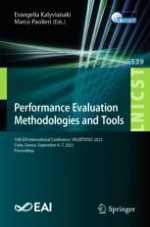This volume contains the proceedings of the 16th EAI International Conference on Performance Evaluation Methodologies and Tools, VALUETOOLS 2023, which took place in Heraklion, Crete during September 6-7, 2023.
The conference brought together researchers, developers, and practitioners from around the world and from different communities including computer science, networks and telecommunications, operations research, optimization, control theory, and manufacturing.
The 27 members of the International Program Committee (PC) helped to provide at least 3 reviews for each of the 30 submitted contributions. Based on the reviews and PC discussions, 11 high-quality papers (9 research papers, 1 tool paper, and 1 work-in-progress paper) were accepted to be presented during the conference.
The volume includes contributions organized into four thematic sessions: Games and Optimization; Simulation; Networking and Queues; Tools.
